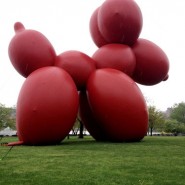When It Comes to Masculinity, Art and Fair Use, SIZE MATTERS.
One of my favorite heavy metal guitarists, Dave Mustaine, has a great saying regarding talent: “It’s not the size of the pencil that matters, it’s how you write your name.”
If only we could get over this preoccupation with SIZE in the so-called art world. It’s ironic, I know. I touched upon this fascination with BIG a few days after the Cariou v. Prince opinion, where I noted — among other modes of socio-cultural discrimination — the Second Circuit’s fascination with Richard Prince’s big one and Patrick Cariou’s little one. Artistically, the three male judges highlighted Prince’s large paintings while symbolically they noted Prince’s large wallet.
Here’s my BIG bit from my previous post.
One other aspect worthy of mention is the language used by the two judges in their opinion. The Court’s fascination with size (e.g.- “measuring approximately,” ” several times that size,” “ten times as large,” “Prince’s collages…measure between ten and nearly a hundred times the size of the photographs.”) would have one think we were reading a narration of what transpires in a boy’s high-school gym.
Yes, my friends, phallocentrism is back, and I can now say that I’m not alone in noticing this recent and current fascination with THE BIG ONE.
Just this past Thursday, The NY Times ran an art review by art critic Roberta Smith. In this review, Gladiatorial Combat: The Battle of the Big, Smith compares the escalating battle between BIG galleries, BIG artists, and BIG artworks. I’m tempted to think that Smith is also giving a nod to my own observations regarding size and the Cariou v. Prince Second Circuit opinion. Here’s Smith,
Whatever you think of [Koons’ and McCarthy’s] exhibitions individually, they provide visual fodder for several prime art world topics: the state of appropriation art in the early 21st century, including the “remade ready-made”; modes of depicting and fabricating figures; and, of course, the effect of the increasing scale of art and galleries on art’s cultural prominence.
The implicitly male mine’s-bigger mentality that has descended on the art world is close to infantile; it afflicts artists, dealers and collectors alike. The bigness guarantees attention, an accessible spectacle. Most people, regardless of how much they know about art, pay attention to something very big, especially if it is accomplished with unusual materials or labor-intensive craft. This is attractive to museums, which need to fill immense atrium spaces with things that draw crowds. At the same time, bigness guarantees exclusivity; it defines art as something only billionaires and oligarchs, not normal people, can possibly own. [Underscore added]
Fascinating, right? How Smith connects size to gender to class: precisely what the three judges in the Cariou v. Prince opted to do, to the benefit of Richard Prince, and with the added element of force of law. Apparently, this preoccupation with BIG has, to my chagrin, not only afflicted those in the art world; it’s also afflicted those in the legal arena.
Apparently, when it comes to masculinity, art and fair use, size matters.
Tags: Art Law, cariou, class, Copyright, fair use, gagosian, gender, masculinity, prince, sculpture, second circuit





Comments